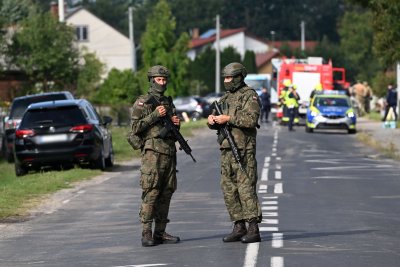NATO military campaign will protect Poland’s Eastern front

1 of 4 | NATO is launching a new military campaign in Poland following an incursion by Russian drones in Polish airspace earlier in the week, the military alliance confirmed in a statement. Photo by Wojtek Jargilo/EPA-EFE
Sept. 13 (UPI) — The North Atlantic Treaty Organization, NATO is launching a new military campaign in Poland following an incursion by Russian drones in Polish airspace earlier in the week, the military alliance confirmed in a statement.
Operation Eastern Sentry will “bolster NATO’s posture along the eastern flank” and “involve a range of Allied assets and feature both traditional capabilities and novel technologies, including elements designed to address challenges associated with drones,” the organization confirmed in a release.
Earlier in the week, Polish and Dutch fighter jets scrambled by NATO shot down more than 20 Russian drones over eastern Poland.
Polish Prime Minister Donald Tusk later confirmed the “multiple violations of Polish airspace,” and the country invoked NATO’s Article 4, convening allied nations to respond.
NATO countries, including the United States, have since pledged their full support for Poland.
This comes after U.S. President Donald Trump questioned Thursday whether the Russian drones could have been accidental.
“It could have been a mistake. It could have been a mistake, but also I’m not happy with anything regarding that situation,” Trump told a reporter asking about the situation.
Tusk responded in a Friday social media post.
“We would also wish that the drone attack on Poland was a mistake. But it wasn’t. And we know it,” Tusk said in response to Trump’s comments.
“No, that wasn’t a mistake,” Polish Foreign Minister Radosław Sikorski added separately on X.
American officials struck a supportive tone Friday.
“The United States stands by our NATO allies in the face of these alarming airspace violations. And rest assured, we will defend every inch of NATO territory,” acting U.S. ambassador to the United Nations, Dorothy Shea said in an address to the U.N. Security Council.
The new military exercise is aimed at deterring further Russian military aggression in NATO airspace or on the ground.
“The violation of Poland’s airspace earlier this week is not an isolated incident and impacts more than just Poland. While a full assessment of the incident is ongoing, NATO is not waiting, we are acting,” NATO Supreme Allied Commander Europe, General Alexus G. Grynkewich, said in a statement issued by NATO’s Allied Command Operations.
“Eastern Sentry and this new approach will deliver even more focused and flexible deterrence and defense where and when needed to protect our people and deter against further reckless and dangerous acts like what occurred earlier this week,” he said.
Denmark, France and Germany have already committed military aircraft to the operation, with Denmark also pledging an anti-air warfare navy frigate. Meanwhile Britain has “expressed its willingness to support,” according to the NATO statement.
In January, NATO launched a similar operation aimed at deterring Russian operations to sabotage deep-sea cables in the Baltic Sea.
The Baltic Sentry program was also implemented by NATO’s Allied Command Operations and came after an undersea cable connecting Estonia and Finland was cut last December.


